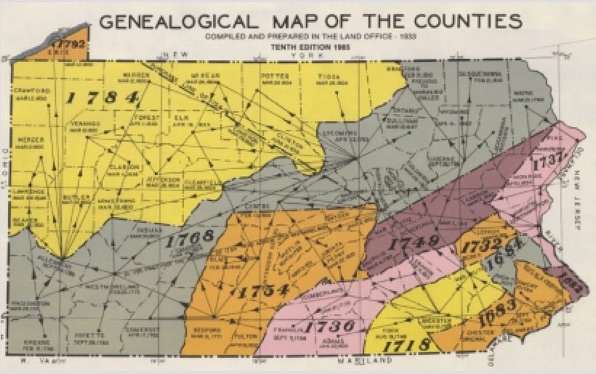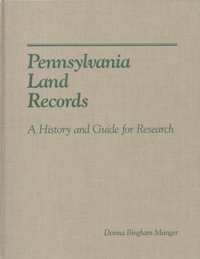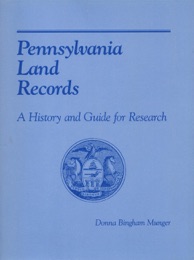DONNA BINGHAM MUNGER
My Own Website
Author, Educator, Historian, Genealogist


DONNA BINGHAM MUNGER
My Own Website
Author, Educator, Historian, Genealogist






PENNSYLVANIA
LAND
RECORDS

Pennsylvania Land Records
A History and Guide for Research
Donna Bingham Munger
Scholarly Resources Inc.
in cooperation with the
Pennsylvania Historical and Museum Commission
1991
Since 1991 when this book was published, the Pennsylvania State Archives has digitized and made available online many of its land records. Using online finding aids, researchers can locate and download images of applications, warrants, surveys, and patents. This History and Guide for Research, published in 1991, was the precursor and impetus for the online records. As such, the book will guide a researcher to the desired records while explaining when, why, and how the records were generated. In short, it is a history of the transfer of Pennsylvania Colonial and State owned land into private ownership.
The records described in the Guide document the process of land settlement in Pennsylvania. Dating from before the establishment of Pennsylvania as a colony and continuing to the present ime, they record the first transfer of land from William Penn, the proprietor; from his heirs, the proprietaries; and from the Commonwealth to purchasers. The records may be classified under two categories: 1) those whose function is basically legal - applications, warrants, surveys, return of surveys, patents, and the minutes, caveats, and depositions of the commissioners of property and Board of Property; and 2) those whose function and present age make them primarily of historical interest such as exoneration certificates, proof of settlement certificates, and special record of purchasers who obtained land in other than normal ways. Examples of the second category are Donation and Depreciation land grants, certified Connecticut Claimants, East Side and West Side applications, and Virginia Entries./ Virtually all records of the proprietary offices of the secretary of the province, surveyor general, receiver general, and master of the rolls, and the Commonwealth offices embodied in the Land Office are involved.
The Guide is designed to be used as a history that can be read straight through from beginning to end, or as a series of reference sections about specific topics. Each section begins with a historical explanation of the events that led to the creation of the permanent records. Then follows an annotated inventory of original loose records and bound volumes.
Researchers must remember that all land in Pennsylvania was owned by one person, William Penn, as a direct grant from King Charles II of England in 1681. William Penn was the sole Proprietor. When he died, his heirs became the Proprietors. Because there was more than one heir, they were called the Proprietaries. The Proprietaries gave up control of all unsold land in 1779 retroactive to July 4, 1776. The Land Office was closed during the Revolutionary War. Deed recording began in 1781.
The Guide is organized in five main sections:
Section I discusses pre-Penn land settlement and the Pennsylvania land records for the period before 1682.
Section II gives a lengthy discussion of land settlement from 1682 to 1732, during the proprietorship of William Penn. The main body of land records generated during this era is extant in the original and in one or more copied versions. Researchers usually find these early records confucing because it is not easy to detect a recording system. This Guide outlines the system and explains how it and the specific records developed.
Section III describes the changing policies and procedures followed by the sons and heirs of William Penn from 1732 to 1776. The proprietaries, as they were called, relied upon the provincial secretary to run their land business much as William Penn had. Many irregular practices developed, especially between 1732 and 1765. After 1765 a more systematic procedure for the transfer of land was established beginning with the East Side and West Side application programs.
Section IV centers on land procedures and records under the Commonwealth from 1776 to 1990. The period to 1905 did not differ much from the colonial era. Although proprietary land became public land under legislative control, procedures and records for titling land changed little.
Section V briefly explains Commonwealth land policy and titling procedures since 1905.
Pennsylvania Land Records, A History and Guide for Research is available in libraries and can be purchased from vendors in various formats. The book is under copyright and must be cited as a source (reference) when used.



Donna Bingham Munger asserts her right to be identified as the author of this website.